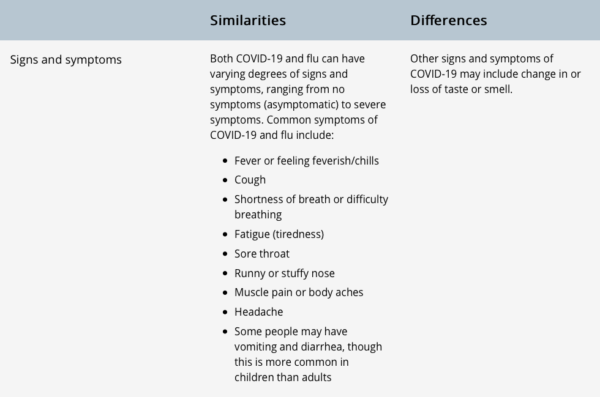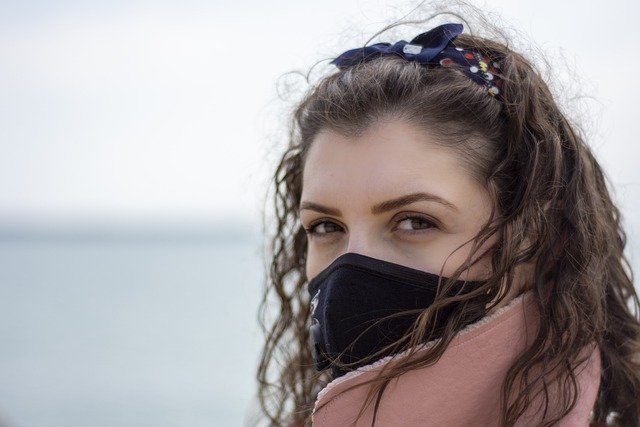South Africa is in the depths of winter, and also nearing the peak of cold and flu season. During an address on June 28, Minister of Health Zweli Mkhize warned that the number of COVID-19 cases may also increase between July and August. When the virus that has caused a global pandemic manifests its symptoms in a similar fashion to the flu, it is easy to panic and fear the worst.
The Centre for Disease Control and Prevention (CDC) recently published a guide listing the similarities and differences between the flu and COVID-19.
What is the difference between Influenza (flu) and COVID-19?
Influenza (flu) and COVID-19 are both contagious respiratory illnesses, but are caused by different viruses. COVID-19 is caused by infection with a new coronavirus (called SARS-CoV-2), while flu is caused by infection with influenza viruses.
“Because some of the symptoms of flu and COVID-19 are similar, it may be difficult to differentiate between them based on symptoms alone, and testing may be needed to help confirm a diagnosis. Flu and COVID-19 share many characteristics, but there are some key differences between the two,” the CDC said.
While more is learned every day, there is still a lot that is unknown about COVID-19 and the virus that causes it. This table compares COVID-19 and flu, given the best available information to date.

Signs and symptoms
Both COVID-19 and flu can have varying degrees of signs and symptoms, ranging from no symptoms (asymptomatic) to severe symptoms.
Symptoms of both COVID-19 and flu include:
- Fever or feeling feverish/chills
- Cough
- Shortness of breath or difficulty breathing
- Fatigue (tiredness)
- Sore throat
- Runny or stuffy nose
- Muscle pain or body aches
- Headache
- Some people may have vomiting and diarrhea, though this is more common in children than adults
Other signs and symptoms of COVID-19 may include change in or loss of taste or smell.
How long symptoms appear after exposure and infection
For both COVID-19 and flu, one or more days can pass between a person becoming infected and when he or she begins to experience illness symptoms.
If a person has COVID-19, it could take them longer to develop symptoms than if they had flu.
COVID-19
Usually, a person develops symptoms approximately five days after being infected, but symptoms can also appear as early as two days after infection. Sometimes symptoms may also be late as 14 days after infection.
Flu
Usually, a person develops symptoms anywhere from one to four days after infection.
How long someone can spread the virus for
For both COVID-19 and flu, it’s possible to spread the virus for at least 1 day before experiencing any symptoms.
If a person has COVID-19, they may be contagious for a longer period of time than if they had flu.
COVID-19
- How long someone can spread the virus is still under investigation. It’s possible for people to spread the virus for approximately two days before experiencing signs or symptoms and remain contagious for at least 10 days after signs or symptoms first appeared.
- If someone is asymptomatic or their symptoms go away, it’s possible to remain contagious for at least 10 days after testing positive for COVID-19.
Flu
Most people are contagious for about 1 day before they show symptoms. Older children and adults with flu appear to be most contagious during the initial three to four days of their illness but many remain contagious for about seven days. Infants and people with weakened immune systems can be contagious for even longer.
How it spreads
- Both COVID-19 and flu can spread from person-to-person, between people who are in close contact with one another.
- Both are spread mainly by droplets made when people with the illness (COVID-19 or flu) cough, sneeze, or talk.
- These droplets can land in the mouths or noses of people who are nearby or possibly be inhaled into the lungs.
- It may be possible that a person can get infected by physical human contact – such as shaking hands – or by touching a surface or object that has virus on it and then touching his or her own mouth, nose, or possibly their eyes.
- Both the flu virus and SARS-CoV-2 may be spread by people before they begin showing symptoms, by those with very mild symptoms or who never developed symptoms (asymptomatic).
“While COVID-19 and flu viruses are thought to spread in similar ways, COVID-19 is more contagious among certain populations and age groups than flu. Also, COVID-19 has been observed to have more super-spreading events than flu. This means the virus that causes COVID-19 can quickly and easily spread to a lot of people and result in continuous spreading among people as time progresses,” the CDC said.
People at high-risk for severe illness
Both COVID-19 and flu can result in severe illness and complications. Those at highest risk include:
- Older adults
- People with certain underlying medical conditions
- Pregnant people
School-aged children
School-aged children infected with COVID-19 are at higher risk of Multisystem Inflammatory Syndrome in Children (MIS-C), a rare but severe complication of COVID-19.
Young children
The risk of complications for healthy children is higher for flu compared to COVID-19. However, infants and children with underlying medical conditions are at increased risk for both flu and COVID-19.
Complications
Both COVID-19 and flu can result in complications, including:
- Pneumonia
- Respiratory failure
- Acute respiratory distress syndrome (i.e. fluid in lungs)
- Sepsis
- Cardiac injury (e.g. heart attacks and stroke)
- Multiple-organ failure (respiratory failure, kidney failure, shock)
- Worsening of chronic medical conditions (involving the lungs, heart, nervous system or diabetes)
- Inflammation of the heart, brain or muscle tissues
- Secondary bacterial infections (i.e. infections that occur in people who have already been infected with flu or COVID-19)
Additional complications associated with COVID-19 can include:
Blood clots in the veins and arteries of the lungs, heart, legs or brain Multisystem Inflammatory Syndrome in Children (MIS-C).
Approved Treatments
People at high-risk of complications or who have been hospitalised for COVID-19 or flu should receive supportive medical care to help relieve symptoms and complications.
COVID-19
The National Institutes of Health (NIH) has developed guidance on treatmentexternal icon, which will be regularly updated as new evidence on treatment options emerges.
While remdesivir is an antiviral agent that is being explored as a treatment for COVID-19 and is available under an Emergency Use Authorization (EUA), there are currently no drugs or other therapeutics approved by the Food and Drug Administration (FDA) to prevent or treat COVID-19. Studies are in progress to learn more.
Flu
Prescription influenza antiviral drugs are FDA-approved to treat flu. People who are hospitalised with flu or at high-risk of flu complications with flu symptoms are recommended to be treated with antiviral drugs as soon as possible.
Vaccine
Vaccines for COVID-19 and flu must be approved or authorised for emergency use (EUA) by the FDA.
COVID-19
Currently there is no vaccine to prevent COVID-19. Vaccine developers and other researchers and manufacturers are expediting the development of a vaccine to prevent COVID-19.
Flu
There are multiple FDA-licensed influenza vaccines produced annually to protect against the 3 or 4 flu viruses that scientists anticipate will circulate each year.
Picture: Pixabay






